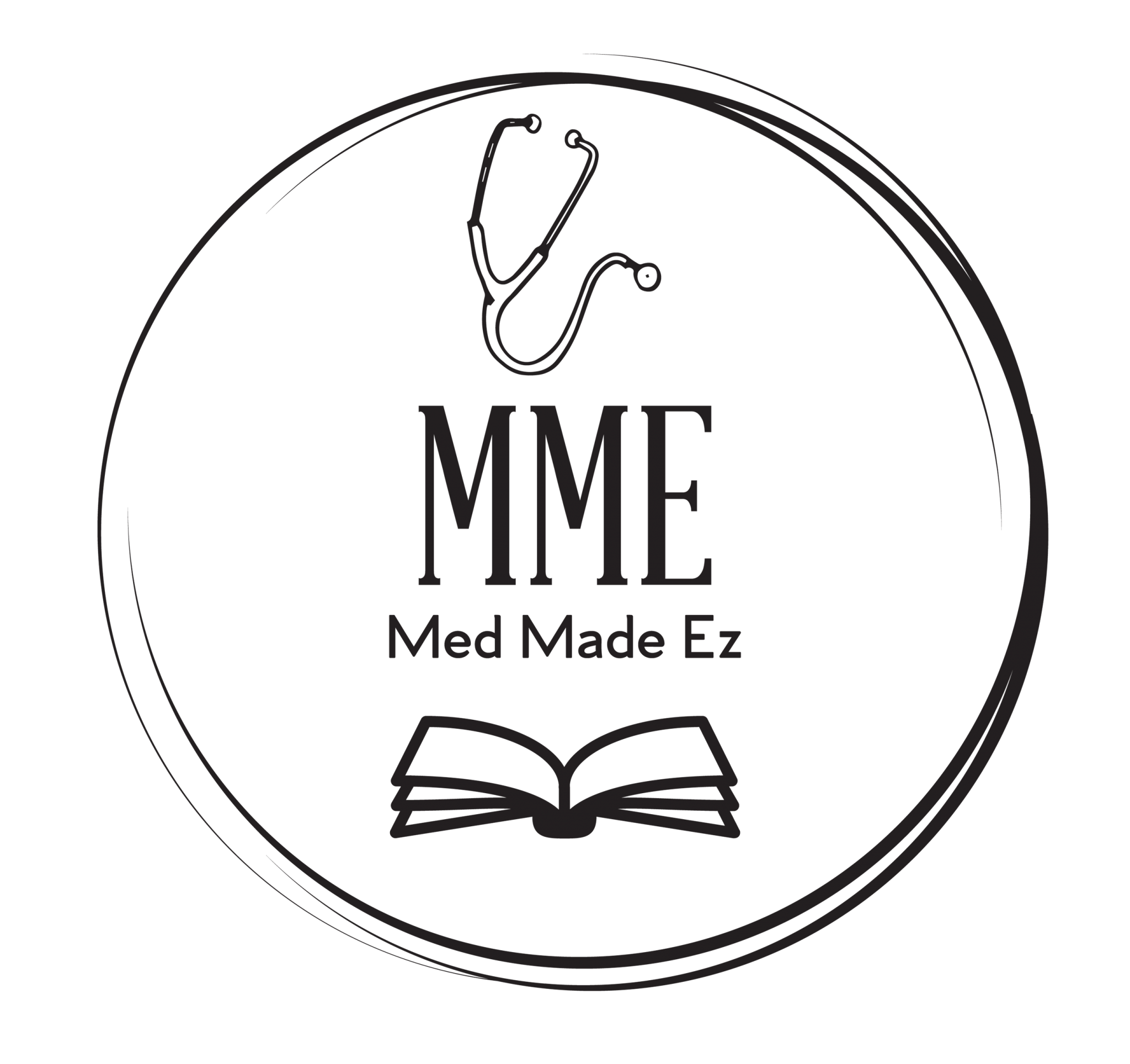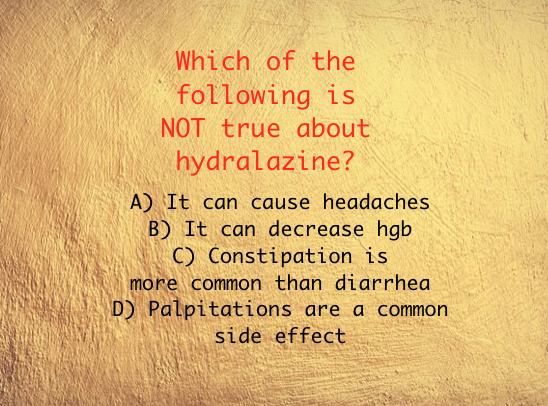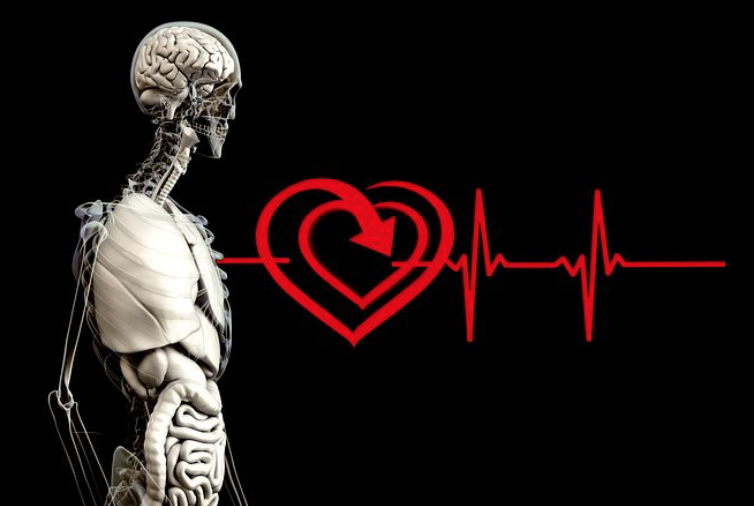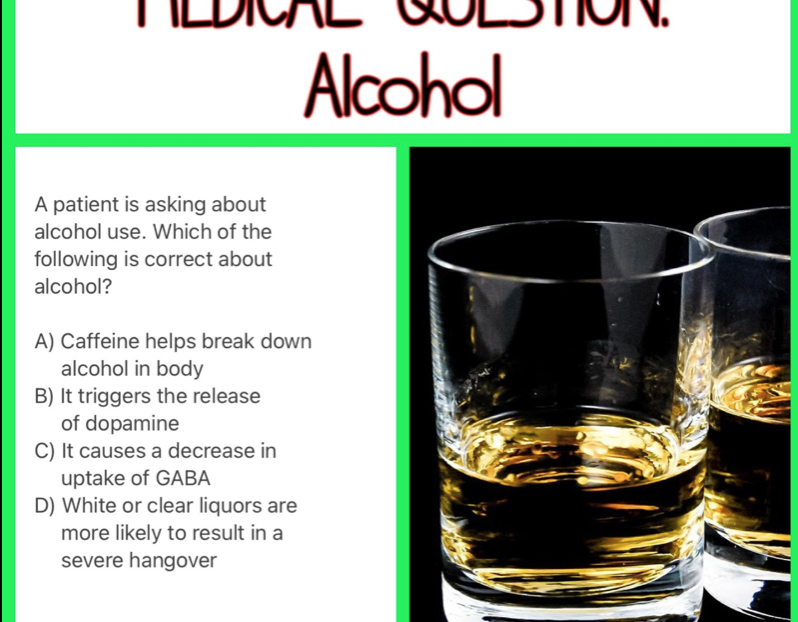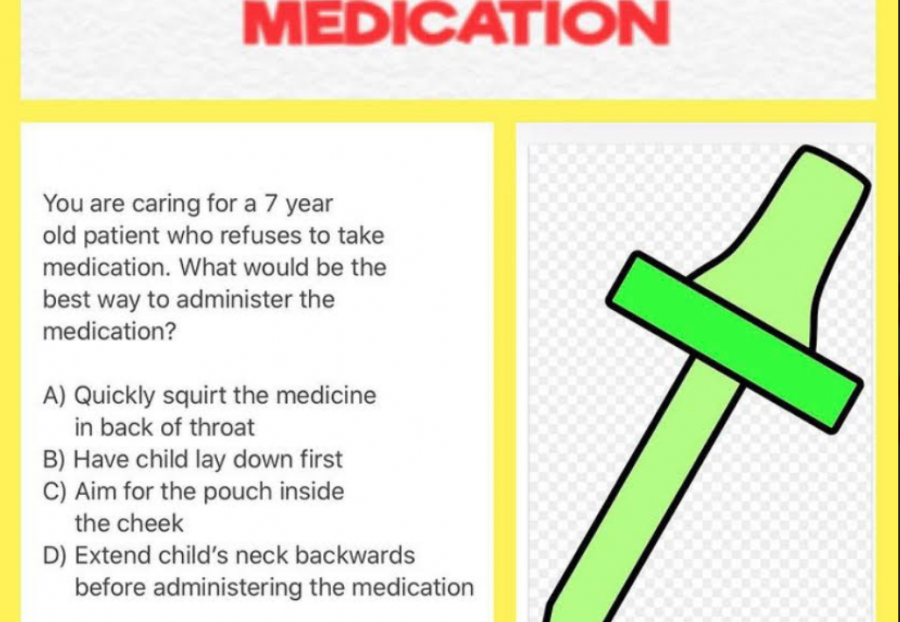NCLEX DIAGNOSIS QUIZ & STUDY GUIDES
Addison’s Disease:
- Hypotension
- Salt craving
- Hyponatremia
- Syncope
- Hyperkalemia
- Darkening of skin
- Fever
- Not enough cortisol
Basal Cell Carcinoma
- Slow growing
- Waxy or Pearly appearance nodules
- Usually on face
- Usually in females >40 yrs old
Bulimia Nervosa:
- Elevated amylase
- Over preoccupied with weight, shape, appearance
- Binge eating recurrent
- Hoarse voice
- Sore throat
- Recurrent diuretic, laxative use
Congestive Heart Failure:
- Shortness of air
- Rapid weight gain
- JVD
- Extremity swelling
- Orthopnea
- Elevated BNP
COPD:
- Wheezing
- Thick sputum
- Clubbed finger nails
- Barrel chest
- Coughing
- Shortness of breath
Crohns:
- Diarrhea
- Weight loss
- Malnutrition
- Abdomen pain
- Blood in stool
- Fever
- Fatigue
Croup:
- Barky seal like cough
- Hoarseness
- Inspiratory stridor
- Neck Xray= + Steeple sign
- Cause: Virus usually parainfluenza (1,2,3)
Cushing Syndrome:
- Acne
- Buffalo hump
- Moon Face
- Osteoporosis
- Striae
- Hyperglycemia
- Central obesity
- Too much cortisol
Cataracts:
- Cloudy vision
- Blurred vision
- Halos around lights
- Fading of colors
- Sensitivity to light
Cystic fibrosis:
- Inability to gain weight
- Meconium ileus (newborns)
- Repeated lung infections
- Wheezing
- Nasal congestion (from thick mucus)
- Persistent cough
- Greasy foul smelling stools
- Growth development delays
Depression
- Lack of motivation
- Excessive sleep
- Irritable
- Feeling hopeless
- Less interest in previous hobbies/activities
- Decreased energy
Glaucoma (angle closure)
- Severe pain in eye
- Headache
- nausea and or vomiting
- Decreased vision
- Blurred vision
- Increased intraocular pressure
Diabetes:
- Polydipsia (increased thirst)
- Polyuria (increased urination)
- Polyphagia (increased hunger)
- A1c >6.4
DKA:
- Kussmaul breathing
- Nausea and or vomiting
- Abdomen pain
- Hyponatremia
- Confusion
- Glucose >250
- Polydipsia
- Polyphagia
- Polyuria
Epiglottitis:
- Hot potato voice
- Drooling
- Severe sore throat
- Leaning forward helps with symptoms
- Neck Xray= + Thumb sign
- Anxious, restless
- Fever
- Don’t examine the throat if suspected!
Failure to Thrive:
- Lack of weight gain
- Developmental delays
- Irritability
- Fatigued
- Excessive sleepiness
- Learning difficulties
Hepatitis:
- Jaundice
- Elevated liver enzymes
- Nausea and vomiting
- Ascites
HELLP Syndrome:
- H- Hemolysis
- EL- Elevated liver enzymes
- LP- Low platelets
- Happens in connection with preeclampsia
Herpes Zoster (Shingles):
- Usually does not cross midline (is on one side of body)
- Vesicles in clusters
- Nerve pain severe even when rash has not erupted yet
- usually over the age 50 yrs old
- Crusting of vesicles in 7-10 days
- Numbness & tingling ina rea of rash
- Tzanck smear helps to diagnose
Hypertensive Urgency:
- Blurred vision
- Dizziness
- Nausea/vomit
- Headache
Influenza:
- Myalgias
- Dry cough
- Headache
- Pharyngitis
- May have +rapid influenza test
Mono:
- Severe fatigue
- Weakness
- Pharyngitis
- Lymphadenopathy
- Splenomegaly
- Left upper abdomen pain
Multiple Sclerosis:
- Blurred vision (early sign)
- Weakness
- Difficulties walking
Meningitis:
- Brudzinski sign+
- Kerning sign+
- Photophobia
- Stiff neck
- Headache
- High fever
Osteoporosis
- Bones that break easily
- Stooped posture
- Back pain
- Loss of height
Parkinsons:
- Shuffled gait
- Tremors
- Bradykinesia (slow movement)
- Rigidity
- Pill rolling
- Urine retention
- Mask like face
Pneumothorax:
- Shortness of breath
- Chest pain
- Recent chest trauma (potentially)
- Chest tightness
- Cyanosis
- Tachycardia
Rhabdomyolysis:
- Tea colored urine
- Elevated creatine kinase (CK)
- Myalgias (muscle aches)
- Renal failure
- Liver failure
- Statin use (risk)
- Recent fall (risk)
Lymes Disease:
- Erythema migrans (bull’s- eye skin rash)
- Severe fatigue
- Arthralgias
Neuroleptic malignant syndrome (NMS):
- Hypertension
- Hyperthermia >103 temp
- Muscle rigidity
- Tachycardia
- Use of certain antipsychotic meds can cause ex (especially older ones):
- Thorazine
- Haldol
- Loxitane
Rheumatoid Arthritis
- Malaise
- Insidious onset
- Fevers
- RF elevated
- Arthralgia’s (Aching joints)
- Polyarthritis of hands & feat
- Stiffness
- CRP elevated
Lupus
- Arthralgias
- Butterfly rash on face
- ANA elevated
- Fevers
- Can have multi system involvement (including kidneys)
Serotonin Syndrome:
- Agitation
- Confusion
- Diaphoretic
- Tachycardia
- Muscle rigidity
- Inability to control muscles
- High fever
- Seizure
Impetigo:
- Honey colored crust over lesions
- Usually around mouth nose area in kids
Scabies
- Itching worse at night
- Look between fingers in webs of finger-black dots
Cauda Equina:
- Numbness tingling in sacral area
- Low back pain severe
- Loss of sensation in legs, butt area
- Bowel or bladder dysfunction
- Sexual dysfunction
- Abdominal aortic aneurysm
- Aorta is main supplier of blood in body
- May have an abdominal pulsation
- May complain of abdomen & back pain that is tearing
- Trauma might cause
- Risk factors: male, hypertension, smoking, atherosclerosis
- Acromegaly
- Hormonal disorder–>too much growth hormone
- Pituitary tumor might be the cause–tumor produces excess growth hormone
- Sexual dysfunction
- Coarse facial features, oily skin, excessive sweating
- Joints may ache
- Acute Renal failure
- Hydration so important!
- The cause of the ARF needs to be identified
- Medications
- Dehydration
- Kidney stones and or infections
- Urine retention
- Infections-sepsis
- Blood loss-hypovolemia
- Addison insufficiency- adrenal crisis
- Syncope
- Hyperpigmentation of skin
- Hypotension
- Fever
- Weight loss
- Salt cravings
- Alcoholism
- S/S withdrawal: n/v, tremors, tachycardia, high blood pressure, fevers, hallucinations, agitation
- May see elevated liver enzymes
- GGT may be elevated
- Know CAGE questions
- C- feel need to CUT down
- A- ANNOYED when people talk about the alcohol use
- G- GUILT about drinking
- E- EYE-OPENER need to drink first thing in morning
- Alzheimer’s disease
- May see a decline in ADL’s
- Misplace things easily
- Wandering
- Personality changes
- Identification bracelet is important for these patients to have
- Antisocial personality disorder
- No regard for laws
- Lack of empathy
- Impulsive
- Lack of remorse
- No respect for the rights of others
- Appendicitis
- Psoas & obturator sign+
- Leukocytosis
- Right lower quadrant abdomen pain
- Asthma
- Atrial fibrillation
- Irregular heart beat
- Tx with beta blocker (rate control), anti-arrhtymic, and anticoagulation
- Can cause stroke if uncontrolled
- Electrolyte abnormalities can flare
- Autism
- Bipolar
- Lithium: give during meals to avoid GI upset
- Baseline EKG, thyroid studies
- Dehydration can lead to lithium toxicity
- Avoid alcohol while taking this med
- Avoid major changes in salt intake while on this med-low salt intake may lead to higher levels of lithium
- Lithium: give during meals to avoid GI upset
- Bulimia
- Elevated lipase
- Burns
- Cardiac Tamponade
- Fluid accumulates around heart
- Hypotension, distended neck veins, distant heart sounds
- Beck’s Triad
- C-diff
- Treat with Flagyl and or PO vancomycin (IV vanc won’t work)
- Contact precautions-must wash hands
- These patients should have a single room
- Celiac disease
- No gluten
- Many different vague symptoms
- Cellulitis
- Chronic renal failure (CKD)
- <15 GFR usually indicated a need for dialysis
- Have to limit foods high in phosphorus and potassium (know examples!)
- If patient has a fistula- no blood pressure or IV stick on the side of the fistula
- Daily weight and accurate I/O important
- Congestive heart failure
- JVD, swollen extremities, weight gain sudden
- Lasix to treat
- Echo to determine EF how well heart functioning
- Daily weights, low sodium diet
- COPD
- Purulent sputum
- Hx tobacco use
- SOA
- Wheezing
- Dyspnea with exertion
- Crohns
- Cushing’s syndrome
- Cystic fibrosis
- Dehydration
- May have acute renal failure
- Need accurate I/Os
- IV fluids important
- Hold meds that may cause renal injury
- Dementia
- Depression
- Diabetes
- Think 3 P’s polydipsia, polyphagia, polyuria
- HbA1c >6.4
- Daily foot checks
- Yearly eye exam
- Diverticulitis
- Left sided abdomen pain
- Fever chills
- Constipation
- Recent eating seeds, popcorn
- Tx: Flagyl & fluoroquinolone
- CT abdomen to help Dx
- Low fiber residual diet in acute flare
- DKA
- Confusion, nausea, vomit, abdomen pain
- Polydipsia, polyphagia, polyuria
- Acetone/anion gap high
- Dehydration
- Treat with fluids, insulin, watch potassium & other electrolytes
- DVT
- Pain in calf
- Swelling and or erythema in extremities
- Ectopic pregnancy
- Gestational Diabetes
- Gastroenteritis
- Nausea, vomiting, diarrhea, fever
- Recent sick contact, eating spoiled/old food
- New restaurants or travel
- GER
- GERD
- Sx: epigastric chest pain
- GI Bleed
- Anemia
- Weakness
- Blood in stool- upper coffee ground or black, bright is lower
- Abdomen pain
- Hx NSAID, anticoagulation use
- Glaucoma
- Glomerulonephritis
- Gonorrhea
- Hepatitis
- HIV
- Hyperemesis gravidarum
- Hyperlipidemia
- Hypertension
- Nausea
- Headache
- Dizziness
- Blurred vision
- Hypothyroidism
- Dry skin
- Bradycardia
- Fatigue
- Weight gain
- Intussusception
- Currant jelly appearing stool
- Sausage shaped mass in abdomen
- Abdomen pain
- Nausea/vomit
- Kawasaki
- High fever
- Peeling skin
- Rash- trunk & genitals
- Strawberry tongue
- Red skin- palms of hands & soles of feet
- Marfan syndrome
- Tall and slender
- Long arms
- MVP common
- Crowded teeth
- Flat feet
- Scoliosis
- Migraines
- Myocardial infarction
- Elevated cardiac enzymes
- ST elevation on EKG
- Asa 325 mg dose
- MONA (morphine, oxygen, nitro, aspirin)
- Myxedema coma
- Severe hypothyroidism
- Facial edema
- Confusion
- Multiple Sclerosis
- MRI to diagnose
- Early sx: vision changes
- Late sx: tremors, muscle spasms, memory problems
- Necrotizing Fasciitis
- Nephrotic syndrome
- Osteogenesis imperfecta
- Osteomyelitis
- Fever chills
- May developed from skin ulcer
- Osteoporosis
- Otitis media
- Ovarian cancer
- Pancreatic cancer
- Pancreatitis
- ETOH most common cause
- Viruses & certain meds can also cause
- TX: usually NPO & aggressive fluids
- Paraplegia
- Watch for skin breakdown
- Parkinson
- Tremors, Rigidity, Slow moment, Pill rolling, mask like face
- Concerns of falling
- Peptic ulcer disease
- Peripheral vascular disease
- Pernicious anemia
- Phenylketonuria (PKU)
- Pneumocystis
- Pneumonia
- Back pain mid thoracic between shoulder blades
- Cough, fever, chills, fatigue, brown colored sputum
- Chest pain
- Polycythemia vera
- Preeclampsia
- Proteinuria
- Edema in extremities
- Headache
- Elevated blood pressure
- Usually after 20 week
- Pregnancy induced hypertension
- Pressure Ulcer
- Pulmonary embolism
- Heparin or Lovenox injections usual treatment
- Most common causes: prolonged bedrest, road trips, cancer history, clotting disorders, birth control use
- Pyloric stenosis
- Olive shaped mass epigastric area
- Male infant more common
- Projectile vomiting
- Poor weight gain
- Retinal detachment
- Grey veil across vision
- Floaters
- Diabetes & family history increase the risk of developing
- Rheumatic fever
- Rheumatoid arthritis
- Schizophrenia
- Sepsis
- Hypotension, fever, tachycardia
- 30 ml/kg boluses
- Prompt IV anbx administration cater to the source
- Serotonin syndrome
- Sickle cell anemia
- Chest pain often a symptoms
- Fluids & pain control main treatment
- Common in African American individuals
- Stroke
- aphasia, confusion, facial droop, unilateral weakness
- Dizziness
- CT head first but may need MRI if nothing shows on CT
- A fib uncontrolled can cause
- Syphillis
- RPR to help Dx
- 1st stage: painless chancre on genitals
- 2nd stage: lesions/rash on palms hands & soles feet
- Latent stage: no signs or sx
- Tertiary stage: 10-30 yrs after infection started-can affect many organs
- Testicular torsion
- Physical exam test: cremaster test
- Medical emergency
- Blood supply to testicles cut off with the twisting
- Ultrasound to help diagnose
- TIA
- Tuberculosis
- Positive PPD to help screen for this
- CXR to help diagnose
- Hemoptysis, fever, coughing
- CRP elevated
- Turner syndrome
- Affects females
- One of X chromosomes missing or partially missing
- Poor growth is often an early sign
- Web-like neck, wide set ears, broad chest, short fingers
- Swelling hands common
- Ulcerative colitis
- Bloody stools
- Anemia
- Wilm’s tumor
- Abdomen pain
- Don’t palpate abdomen
- Amniotomy
- Appendectomy
- Amputations
- Bowel resection
- Breast biopsy
- Bronchoscopy
- Cardiac catheterization
- Carotid endarterectomy
- Cataract surgery
- Cesarean section
- Cholecystectomy
- Coronary artery bypass
- Debridement
- Endarterectomy
- Femoral popliteal bypass graft
- Hysterectomy
- Laryngectomy
- Lobectomy
- Organ Transplants
- No fresh fruits (need to be cooked or peeled if skin) and/or flowers
- Teaching–> CANNOT miss immunosuppressants
- ORIF
- Skin graft
- Thoracentesis
- Thyroidectomy
- Tonsillectomy
- Tracheostomy
- TURP
- Blood loss is most common complication after TURP
- CBI (continuous bladder irrigation) after TURP surgery
- Whipple
KEY POINTS AFTER ANY SURGERY:
- Watch for drops in blood pressure & tachycardia could indicate:
- Sepsis
- Hemorrhage
- Pain medication effects
- Anesthesia effects
- Watch for bradypnea
- Narcotics & anesthesia can cause a person to stop breathing
- Urine output
- Can indicate renal failure, dehydration
- May indicate the need for fluids
- Bowel sounds
- Constipation common after surgeries
- If bowel sounds not present, if patient eats they may have more nausea and vomiting
- Semiprivate rooms
- Don’t room a fresh post op patient with a patient who has an infection
- Adrenal Insufficiency:
- Hyponatremia
- Hyperkalemia
- Anemia
- Alcoholism:
- Hypomagnesemia
- Thrombocytopenia
- Hyponatremia
- CHF:
- BNP: increased
- Echo: Ejection Fraction lowered
- Chronic renal failure
- GRF: decreased
- Creatinine: sometimes increased
- Hgb: decreased
- Phosphorus: increased
- Potassium: Can be increased
- COPD exacerbation:
- Elevated C02
- Low pH
- Cushing’s Disease:
- Hyperglycemia
- Cortisol: High
- DKA:
- Ketonuria
- Glucose >250
- pH <7.3 (ABG’s)
- Anion gap >10
- Hyperkalemia
- Hyponatremia
- Hypothyroidism:
- TSH increased
- Free T4 decreased
- Lupus:
- ANA: elevated
- Myxedema Coma
- Hypoglycemia
- Hyponatremia
- Free T4 low (severe)
- TSH high
- Sepsis:
- Renal failure
- Lactic acidosis
- Liver enzyme elevation
- Leukocytosis
- Temporal arteritis:
- Elevated SED rate
- Alcoholism
- Cirhossis-liver failure: jaundice, ascites, confusion, nausea, vomit
- Esophageal varicies: vomiting blood, anemia
- Esophageal damage
- Pancreatitis
- Esophageal cancer
- Hepatocellular carcinoma
- Stroke
- Encephalopathy
- Ankylosing spondylitis
- Uveitis/Iritis- reddened, swollen, painful eyes
- Joint damage
- Osteoporosis
- Atrial fibrillation
- Heart failure- swelling in extremities, JVD, sudden weight gain
- Strokes-A fib can cause
- COPD
- Respiratory failure
- Pneumonia often
- Diabetes:
- Renal failure
- Peripheral neuropathy: numbness & tingling in feet
- Blindness
- Hypertension:
- Renal failure
- Heart failure
- Enlarged heart
- Strokes
- Lyme’s Disease
- Bells palsy- unilateral facial droop, inability to close eyelid
- Pulmonary Embolism
- Cancer is a risk factor
- Factor V Leiden deficiency
- Rosacea
- Ocular rosacea- constant dry and red eyes
